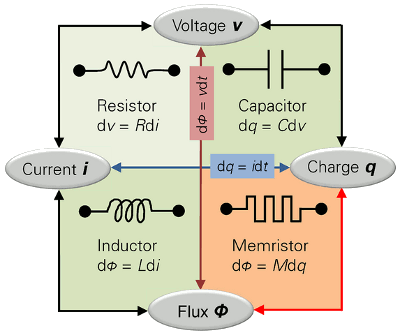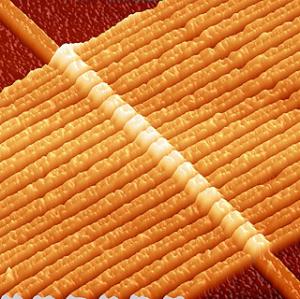Memristor Identity Crisis
June 11, 2012
First, a mild
disclaimer. None of this article is criticism of someone's research. The problem discussed is one of
nomenclature, not
scientific misconduct. It's also good to realize that the greatest discoveries get the most criticism, since lesser "
discoveries" are just ignored. If
Alexander Graham Bell had invented a better
post hole digger, I'm sure he would not have needed to defend his
patents in the courts for so many years.
The controversy is about a supposed
electrical circuit element called a
memristor. As its name implies, it's a
resistor with a
memory; specifically, a memory of how much
current has passed through it. In this
information age, such a device would be useful. If someone asked me to make such a device, there would be various ways I could do it. If you wanted it in a day and weren't worried about its size or performance, I could combine a
microcontroller and a
field effect transistor to produce such a device.
To produce a more elegant device, I would likely look back into the decades old
technology of
tungsten oxide electrochromic devices that work by reversibly
plating one material onto another in an
electrochemical cell. If such a device were really important, a little research would yield far better material systems, and a better device.
The problem, however, is that the memristor is supposedly a fundamental device, not a device that depends on any material system. Its properties are predicted by looking at the
symmetry of the fundamental electrical devices,
resistors,
capacitors and
inductors, and filling in the gap.
Resistor: ∂v = R⋅∂i
Capacitor: ∂q = C⋅∂v
Inductor: ∂φ = L⋅∂i
Memristor: ∂φ = M⋅∂q
In these equations, v is the
voltage, i is the
current, φ is the
magnetic flux; and R, C, L and M are the
resistance,
capacitance,
inductance and
memristance. The fundamental symmetry can be seen easily in the following figure, which shows these four electrical elements much like the
ancients represented their
four elements.

The four electrical elements.
(Via Wikimedia Commons))
Leon Chua, famous for his
eponymous chaotic oscillator circuit, started people thinking about the possibility of the memrister in a 1971 paper.[1] The operation of this element is simply that its resistance will increase when current flows through it in one direction; and, it will decrease when current flows through it in the other direction.
As the equations dictate,
magnetism should be involved because of the flux term, ∂φ, as Chua realized; viz.,
"The physical mechanism characterizing a memristor device must come from the instantaneous (memoryless) interaction between the first-order electric field and the first-order magnetic field."[1]
That was in 1971, and it wasn't until 2008 that the first memristors devices were described. I wrote about these in an
earlier article (Memristor, May 14, 2008). Unlike my microcontroller version mentioned earlier, these were true,
passive devices that didn't need
electrical power. Chua was happy to acknowledge these devices as memristors.
Although these devices do have the resistance properties required of a memristor, the problem is that they don't involve magnetism in any way.
Hewlett Packard's memristor device behaves mathematically as a memristor, but its action is via a
chemical effect and not the faster, and more useful,
electromagnetic effect of Chua's original proposal.

Atomic force microscope (AFM) image of seventeen memristors. The wires are 50 nm wide, which is only 150 atoms.
Photo by J. J. Yang, HP Labs, via Wikimedia Commons)
The original
Hewlett Packard device functioned through
ionic migration in a 5
nanometer film of
titanium dioxide sandwiched between
electrodes. As
electrical charge is accumulated in this film, it becomes charged with
oxygen vacancies that increase its
conductance. The conductance effect of vacancies in bulk titanium dioxide was known for years prior to its use in memristors. It's used in some types of
oxygen gas sensors.
An analysis of the true nature of the memristor has been published on the
arXiv Preprint Server by
Sascha Vongehr of the
Department of Philosophy,
Nanjing University,
China.[6] Vongehr is skilled to comment in this area, since he also has an appointment at the
National Laboratory of Solid-State Microstructures (Nanjing, China), and he has a
physics Ph.D. from the
University of Southern California.
Vongehr writes that true memristor devices may not exist at all, since there are reasons that they might be unstable. Says Vongehr, "The memristor is either impossible or still to be discovered."[6] And it's not just he who has doubts. Devices that perform as memristors were produced earlier than 2008,[7] but the discoverers of these devices did not claim them to be memristors, nor did they claim prior discovery after publication of the 2008 work.
Vongehr writes that "memristor" was a catchy label, so there was a flood of memristors papers without any critical thought as to what a memristor really is. I can relate to that, since I once worked in the area of
magnetic bubbles, which seemed to persist long after its utility, perhaps because it, too, had a catchy label. Vongehr's hope is that the mis-definition of memristors doesn't stop its actual discovery; or, proof that memristors, indeed, don't exist.[6]
References:
- Leon O. Chua, "Memristor" The Missing Circuit Element", IEEE Transactions on Circuit Theory, vol. CT-18, no. 5 (September 1971), pp. 507-519.
- R. Colin Johnson, "'Missing link' memristor created: Rewrite the textbooks?" (EETimes, April 30, 2008).
- Dmitri B. Strukov, Gregory S. Snider, Duncan R. Stewart, and R. Stanley Williams, "The missing memristor found," Nature, vol. 453 (1 May 2008), pp. 80-83.
- HP Labs Proves Existence of New Basic Element for Electronic Circuits (HP Press Release, April 30, 2008).
- Jamie Beckett, "Demystifying the memristor: Proof of fourth basic circuit element could transform computing," (HP Press Release, April, 2008).
- Sascha Vongehr, "The Missing Memristor: Novel Nanotechnology or rather new Case Study for the Philosophy and Sociology of Science?" arXiv Preprint Server, March 1, 2012.
- H. M. Upadhyaya and Suresh Chandra, "Polarity dependent memory switching behavior in Ti/Cd Pb S/Ag system." Semiconductor Science and Technology vol. 10, no. 3 (March, 1995), pp. 332-338.
Permanent Link to this article
Linked Keywords: Disclaimer; nomenclature; scientific misconduct; N-rays; Alexander Graham Bell; post hole digger; patent; electrical circuit element; memristor; resisto; non-volatile memory; memory; electric current; information age; microcontroller; field effect transistor; technology; tungsten oxide; electrochromic; electroplating; plating; electrochemical cell; symmetry; resistor; capacitor; inductor; voltage; electric current; current; magnetic flux; resistance; capacitance; inductance; memristance; Ancient Greece; four elements; Wikimedia Commons; Leon Chua; Chua's circuit; chaotic oscillator circuit; magnetism; passive device; electrical power; Hewlett Packard; chemical; electromagnetic; HP Labs; ionic; nanometer; titanium dioxide; electrode; electric charge; oxygen; vacancy defect; vacancy; conductance; oxygen gas sensor; arXiv Preprint Server; Sascha Vongehr; Department of Philosophy; >Nanjing University; China; National Laboratory of Solid-State Microstructures; physics; Ph.D.; University of Southern California; magnetic bubble.